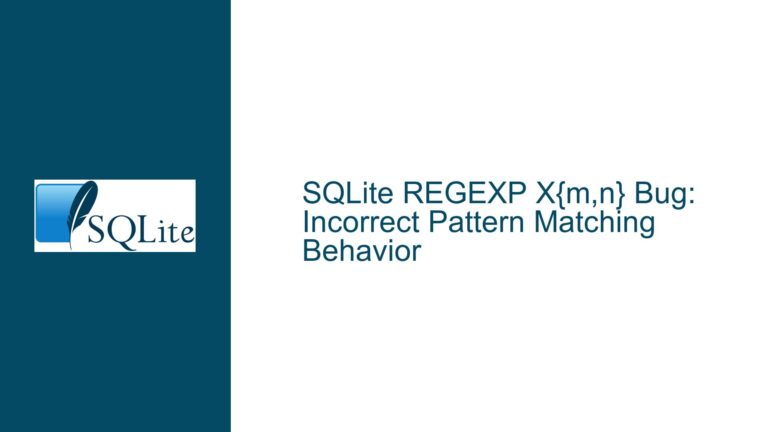Inconsistent Results with EXISTS Subquery in SQLite WHERE Clause
Understanding the Correlated Subquery Behavior in EXISTS Expressions
The core issue revolves around the inconsistent results produced by SQLite when using the EXISTS expression within a WHERE clause, particularly in the context of correlated subqueries. The problem manifests when the EXISTS subquery is evaluated differently depending on whether it is used in a standalone SELECT statement or within an aggregate function like TOTAL. This inconsistency can lead to unexpected results, as demonstrated in the provided SQL statements.
To break it down, the EXISTS expression is used to check whether a subquery returns any rows. When used in a correlated subquery, the subquery references a column from the outer query, meaning it should be re-evaluated for each row of the outer query. However, in the case of the second SELECT statement, the result of the TOTAL function does not align with the expected behavior of the correlated subquery. Instead of returning 1.0, which would be consistent with the first SELECT statement, it returns 2.0. This discrepancy suggests that the EXISTS subquery is not being evaluated as expected in the context of the TOTAL function.
The issue is further highlighted when comparing the results of the third and fifth SELECT statements, where the EXISTS subquery is manually replaced with specific values (10 and 7). These statements show that the subquery behaves as expected when the correlation is removed, returning consistent results. However, when the correlation is reintroduced, as in the first and second SELECT statements, the inconsistency reappears.
This behavior points to a potential flaw in how SQLite handles correlated subqueries within aggregate functions. Specifically, it suggests that the EXISTS expression may not be re-evaluated for each row of the outer query when used in conjunction with an aggregate function, leading to incorrect results.
The Role of the EXISTS-to-IN Optimization in Causing Inconsistencies
The root cause of the inconsistency lies in the EXISTS-to-IN optimization introduced in SQLite. This optimization attempts to convert EXISTS operators into IN operators, which can improve query performance in certain scenarios. However, as demonstrated in the provided SQL statements, this optimization can lead to incorrect results when used with correlated subqueries.
The EXISTS-to-IN optimization works by transforming a subquery that uses EXISTS into an equivalent subquery that uses IN. For example, a query like SELECT * FROM table1 WHERE EXISTS (SELECT 1 FROM table2 WHERE table2.col = table1.col) might be transformed into SELECT * FROM table1 WHERE table1.col IN (SELECT table2.col FROM table2). While this transformation can be beneficial in terms of performance, it can also introduce subtle bugs when the subquery is correlated, as the correlation may not be properly preserved during the transformation.
In the case of the second SELECT statement, the EXISTS-to-IN optimization appears to have caused the subquery to be evaluated only once, rather than for each row of the outer query. This explains why the TOTAL function returns 2.0 instead of the expected 1.0. The optimization effectively breaks the correlation between the subquery and the outer query, leading to incorrect results.
The issue was identified and fixed by backing out the EXISTS-to-IN optimization, as mentioned in the discussion. This decision was made because the optimization was causing other problems in addition to the inconsistency observed in the provided SQL statements. While the optimization may be revisited in the future, it is clear that it needs to be carefully re-evaluated to ensure that it does not introduce similar bugs.
Steps to Troubleshoot and Resolve EXISTS Subquery Inconsistencies
To troubleshoot and resolve inconsistencies related to EXISTS subqueries in SQLite, follow these steps:
Identify the Context of the Subquery: Determine whether the
EXISTSsubquery is correlated or uncorrelated. A correlated subquery references a column from the outer query, while an uncorrelated subquery does not. In the case of the provided SQL statements, the subquery is correlated, as it references thev1column from the outer query.Check for Aggregations: If the
EXISTSsubquery is used within an aggregate function likeTOTAL, be aware that the subquery may not be re-evaluated for each row of the outer query. This can lead to incorrect results, as demonstrated in the secondSELECTstatement. To avoid this issue, consider rewriting the query to ensure that the subquery is evaluated for each row.Verify the Impact of Optimizations: If you suspect that an optimization like
EXISTS-to-INis causing inconsistencies, you can disable the optimization to see if the issue is resolved. In SQLite, this can be done by using thePRAGMAcommand to disable specific optimizations. For example,PRAGMA optimize=OFFcan be used to disable all optimizations, allowing you to isolate the issue.Rewrite the Query: If disabling optimizations resolves the issue, consider rewriting the query to avoid relying on the problematic optimization. For example, instead of using
EXISTSwith a correlated subquery, you could use aJOINor aCASEstatement to achieve the same result. This approach can help ensure that the query behaves as expected, regardless of any optimizations that may be applied.Test with Specific Values: To further isolate the issue, test the query with specific values in place of the correlated column. This can help determine whether the issue is related to the correlation itself or to the broader context of the query. In the provided SQL statements, replacing
v1with specific values (10and7) showed that the subquery behaves as expected when the correlation is removed.Monitor for Future Updates: Keep an eye on future updates to SQLite, as the
EXISTS-to-INoptimization may be revisited and improved. By staying informed about changes to the database engine, you can ensure that your queries continue to perform as expected.
By following these steps, you can effectively troubleshoot and resolve inconsistencies related to EXISTS subqueries in SQLite. The key is to understand the context in which the subquery is used, verify the impact of any optimizations, and rewrite the query if necessary to avoid relying on problematic features. With careful attention to detail, you can ensure that your SQLite queries produce consistent and accurate results.






